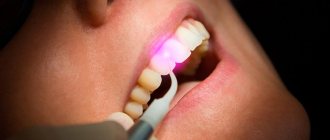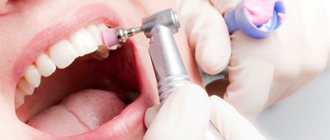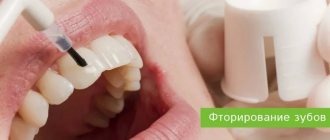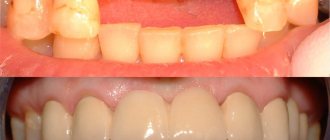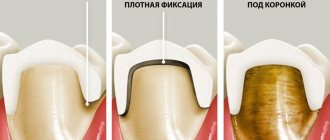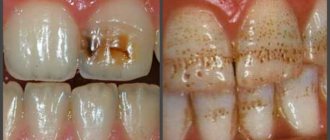Today, metal-ceramics is considered one of the most popular materials for prosthetics in dentistry. Its main advantages are high strength and durability, decent aesthetics and affordable cost. However, in order for prosthetics to be truly durable and reliable, the patient should know how to properly care for metal-ceramic teeth and carry out such care regularly.
Rules for caring for metal-ceramic teeth
Despite the fact that caring for metal-ceramic teeth is quite simple and does not require any special effort, it should be done daily, regularly and carefully - only in this case the patient can be sure that the structures will last a long time and will not cause problems. The basic rules of care are:
- You should brush your teeth at least twice a day, using vertical sweeping movements in the direction from the gums to the cutting edge of the teeth.
- It is better to use a brush with soft bristles that will not injure your gums. You can use the most ordinary toothpaste, but in cases where most of the dentition in the mouth is replaced by dentures, it is better to choose toothpastes that care for the gums (containing herbal extracts or propolis).
- You can’t limit yourself to just cleaning, since you need to care for metal-ceramic crowns just as carefully as you take care of your “natural” teeth, so after each cleaning, the interdental spaces are cleaned with dental floss.
- After cleaning, you should rinse your mouth thoroughly - first with water, and then with an antiseptic solution, which the dentist will recommend.
- If a person smokes, often drinks coffee or other staining and plaque-creating drinks and products, it is necessary to regularly carry out hygienic cleaning at the dentist, since caring for metal ceramics only at home will clearly not be enough. Whitening pastes do not affect artificial teeth and therefore will not give any effect.
Dentists recommend that patients who have metal-ceramic bridge structures installed do not forget to thoroughly clean the rinsing channel located between the crown and the gum during hygiene procedures - if this is not done, food debris will accumulate and gradually decompose in the channel, and bad breath will appear .
Hygiene products for cleaning implants, crowns, dental bridges
To clean fixed dentures you will need the following hygiene products:
. The cleaning brush should have an appropriate degree of bristles so as not to scratch the denture or wear it off. In addition to the main one, you will need a special mono-beam, narrow and thin - for cleaning interdental spaces and difficult places that are inaccessible to a regular brush. It is used after basic brushing; toothpaste is not required for such a cheek.
Toothbrush- Toothpaste . Dentists do not have any special requirements for the paste; you can use a regular one that is suitable for your situation. It is worth noting that whitening pastes or enamel strengthening pastes will not be as effective if you have a lot of fillings, crowns or implants in your mouth. When choosing, dentists recommend giving preference to pastes that have an effect not on the teeth, but on the gums. If you have gum disease or increased plaque formation, you can use pastes with antiseptic properties or herbal extracts.
- Floss . Cleaning the dentures in the area adjacent to the gums is an extremely important step in cleaning. Dental floss will help cope with plaque; for this, there are two types of floss - flat for narrow spaces between teeth, round for wider areas. It is advisable to floss after every meal to remove food particles that get stuck while eating.
- Irrigators and rinses . The irrigator effectively removes bacteria not only from teeth and gums, but also from the tongue. The irrigator can be refilled with both plain water and rinse aid, but it cannot be used during exacerbation of chronic oral diseases. Rinses are prescribed by the dentist if necessary. Consult your doctor before use, especially if you decide to purchase a product with antiseptic or antibacterial properties. Rinsers and irrigators cannot replace full hygiene with a brush and dental floss, so use them after basic procedures.
Caring for fixed dentures is important throughout their lifespan. Careful care of implants and crowns extends their service life, in some cases up to several decades. It is important to remember that in addition to home care, it is necessary to undergo regular preventive examinations, have professional cleaning, and protect dentures from chips, cracks and scratches. At the “Royal Smile” dentistry, after installing implants, crowns or dental bridges, you will receive all the recommendations for caring for them, as well as choosing a brush, paste and additional hygiene products.
How to care for metal-ceramic crowns besides cleaning?
The main misconception of patients who do not know exactly how to properly care for metal-ceramic teeth is that they consider artificial teeth to be stronger than natural ones. As a result, a person may try to chew nuts or eat food that is too cold or too hot. In fact, this cannot be done, since the ceramic coating of a prosthetic structure can be damaged in the same way as natural enamel - chips and scratches form on it from hard food, and cracks from contrasting temperatures.
In addition, many people believe that plaque cannot form on metal-ceramic crowns in principle and therefore it is not necessary to clean them too thoroughly. This is not true - when consuming certain foods and drinks, as well as smoking, plaque still forms, and it is better to remove it in the dentist's office during regular hygiene measures (about once every six months to a year).
The main misconception of patients who do not know exactly how to properly care for metal-ceramic teeth is that they consider artificial teeth to be stronger than natural ones. As a result, a person may try to chew nuts or eat food that is too cold or too hot. In fact, this cannot be done, since the ceramic coating of a prosthetic structure can be damaged in the same way as natural enamel - chips and scratches form on it from hard food, and cracks from contrasting temperatures.
Rules for caring for metal-ceramic teeth
Despite the fact that caring for metal-ceramic teeth is quite simple and does not require any special effort, it should be done daily, regularly and carefully - only in this case the patient can be sure that the structures will last a long time and will not cause problems. The basic rules of care are:
- You should brush your teeth at least twice a day, using vertical sweeping movements in the direction from the gums to the cutting edge of the teeth.
- It is better to use a brush with soft bristles that will not injure your gums. You can use the most ordinary toothpaste, but in cases where most of the dentition in the mouth is replaced by dentures, it is better to choose toothpastes that care for the gums (containing herbal extracts or propolis).
- You can’t limit yourself to just cleaning, since you need to care for metal-ceramic crowns just as carefully as you take care of your “natural” teeth, so after each cleaning, the interdental spaces are cleaned with dental floss.
- After cleaning, you should rinse your mouth thoroughly - first with water, and then with an antiseptic solution, which the dentist will recommend.
- If a person smokes, often drinks coffee or other staining and plaque-creating drinks and products, it is necessary to regularly carry out hygienic cleaning at the dentist, since caring for metal ceramics only at home will clearly not be enough. Whitening pastes do not affect artificial teeth and therefore will not give any effect.
Dentists recommend that patients who have metal-ceramic bridge structures installed do not forget to thoroughly clean the rinsing channel located between the crown and the gum during hygiene procedures - if this is not done, food debris will accumulate and gradually decompose in the channel, and bad breath will appear .
In addition, many people believe that plaque cannot form on metal-ceramic crowns in principle and therefore it is not necessary to clean them too thoroughly. This is not true - when consuming certain foods and drinks, as well as smoking, plaque still forms, and it is better to remove it in the dentist's office during regular hygiene measures (about once every six months to a year).
Can dentures be whitened?
Can ceramic teeth be whitened? Imagine ordinary dishes made of ceramics and glass - these compositions are inert to chemical bleaches, peroxide, vinegar and other acids, and alkalis. After all, even in laboratories, aggressive chemicals are stored in such containers - and the shade of their walls does not change.
Thus, ceramic veneers, crowns, restoration inlays, and bridges cannot be whitened using chemical methods. Or just lighten the surface darkening a little - and then while it is “fresh”. Those. until the dyes and plaque have eaten into the microscopic pores and cracks on the surface of the ceramic. Abrasive pastes will also only remove surface deposits, and can only harm the prosthesis itself - if solid particles scratch the top coating, it will lose its aesthetics even faster.
Can crowns be whitened?
Today's crowns and veneers are made from a very strong, smooth, and dense material. This means that any surface stains that appear will not be able to penetrate into the composition of the material. Typically, brushing your teeth is enough to keep crowns and veneers looking pristinely clean and bright.
If you are concerned about whitening the color of your teeth if you have crowns or veneers, you may want to consult with your dentist before you begin your teeth whitening procedure. For what? Whitening with crowns or veneers can be a challenge simply because they are not porous and will resist whitening. Artificial crowns against the background of whitened teeth can become noticeable and will be very “conspicuous” and, as a result, you will get a far from beautiful smile, for example, like this one:
Hygiene features
Products made of metal ceramics do not require any special care, as they are durable, their surface is so smooth that they do not accumulate plaque. Care for metal-ceramic teeth must be organized in the same way as for natural teeth, the main thing is to do it regularly and efficiently.
You can clean metal-ceramic teeth with a regular brush.
Metal ceramics do not require a special diet, but you should not test its strength (opening bottles with your teeth, gnawing bones, etc.). Due to such experiments, the ceramic layer may chip, after which the prosthesis will have to be repaired or replaced.
It is also necessary to remember that there is a living tooth under the crown. It is important to prevent food from getting under the crown. Yes, this is possible even with modern technologies that make it possible to produce dentures that fit perfectly to the ground tooth and gum.
Expert opinion. Dentist at the Doctor-RAF clinic. : “The gums are very pliable, so when chewing food, pieces of it can easily push away the mucous membrane and get stuck between the gum and the denture. Over time, inflammation, swelling, and soreness will occur. For this reason, a small distance is specially left between the gum and the crown - a rinsing space. This gap allows the usual rinsing to clear out food that is stuck there.”
Service life of metal-ceramic products
Some patients are mistaken in believing that a metal-ceramic crown will last the rest of their life. Despite the strength and wear resistance, even the operation of this type of product has limitations.
Metal-ceramic dentures, which are based on simple metal, last approximately 10 to 12 years. If an alloy of gold and platinum was used for the frame, the service life will be 15 years, and sometimes more.
The service life of a metal-ceramic prosthesis, like any other, largely depends on the correctness of its manufacture and the patient’s compliance with all the rules for the care and use of this design.
How to whiten darkened teeth if you have crowns and other dentures
If, while wearing ceramic dentures, your teeth become darkened by plaque or tobacco, you can whiten them. To do this, the dentist will select the optimal method for the patient, based on the condition of the teeth - whether they are healthy, whether they have cracks or fillings. Whitening methods in the clinic and at home have already been discussed above. But if, for example, only the old filling has darkened, then it is worth replacing it - putting a new one in the desired shade.
Read on the topic: artistic restoration with a filling - how to make your smile more attractive in 1 visit to the clinic.
You can also cover your natural teeth with veneers or crowns (if they are severely damaged) in a color that perfectly matches the shade of the crowns, bridges or veneers already in your mouth.
Teeth whitening with crowns are the 2 easiest options.
There are two seemingly options you can consider if whitening your natural teeth is a real concern due to the presence of crowns or veneers.
- If the number of crowns is small, for example, on 2-3 front teeth, you can always evaluate the color of the teeth again and redo the crowns in accordance with the new light color of natural teeth. In this case, you should wait 2-4 weeks after whitening for your teeth to acquire a new lighter natural color.
- Switching to dental veneering – this method eliminates the constant need to whiten natural teeth. This method may be an ideal solution when the “neighborhood” of natural and cosmetic teeth does not allow the whitening procedure. The dental veneering procedure allows you to “whiten” your teeth forever and have the desired snow-white smile without the risk of yellowing.
The best method that's right for you should be discussed with your dentist, as they will know best how your teeth may respond to whitening with crowns or veneers. The dentist will suggest which solution will be the most profitable and long-term in order to achieve the cosmetic aesthetics of your smile.
Advantages:
- Possibility of tooth preservation;
- Preservation of tooth shape;
- Possibility to avoid expensive prosthetics.
Whitening of discolored teeth is carried out from the pulp chamber. The technique is based on filling the pulp chamber of the tooth with a chemical reagent. These can be gels, paste-like mixtures, based on drugs such as:
- Sodium perborate (“Endoperox” from Septodont is a powder that is stable in a dry environment, but when interacting with warm air, water, or acid, it decomposes into sodium metaborate, hydrogen peroxide and oxygen. When mixed with hydrogen peroxide, its effect is enhanced).
- Carbamide peroxide (“Belagel O” from Vladmiva - a gel with 20% and 30% concentration of the active substance, it also contains potassium ions, which reduce sensitivity).
- Hydrogen peroxide (“Opalescence Endo” from Ultradent – a gel containing 35% hydrogen peroxide).



